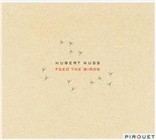Home » Jazz Articles » Album Review » Hubert Nuss: Feed the Birds
Hubert Nuss: Feed the Birds
Teamed with bassist John Goldsby—most recently heard on Cologne, his collaboration with pianist Bill Dobbins and drummer Peter Erskine—and drummer John Riley, both members of the WDR Big Band, Nuss' choice to record a mixed programme of originals and standards facilitates his ability to apply his own multi-hued approach to any context. While one might expect—or, at least, hope for—a certain amount of originality in the self-penned compositions, Nuss' unique approach to the standards may be the most surprising aspect of the disc.
Nuss takes "With a Smile and a Song, from Disney's Cinderella, and opens it up to a liberal interpretation. Starting with a pulsing pedal point from Goldsby and delicate cymbal work from Riley, Nuss eases into the familiar theme, even as he significantly alters its harmonic foundation. Without drawing too strong a comparison between this trio and saxophonist Wayne Shorter's current quartet, it's possible to link them from the perspective of just how radically Shorter's group alters not only his own material, but others' as well, specifically Arthur Penn's "Smilin' Through on the recent Beyond the Sound Barrier. Shorter's group is more consistently unencumbered—Nuss' reading of the Haggard/Burke standard "What's New is more in the mainstream, though not without a disposition to open it up harmonically, even as it remains rhythmically centred. But Nuss, Goldsby, and Riley push the envelope, more gently and with a clearer respect for the shape of the boundaries.
Gentle, in fact, is a good word to apply to the overall tenor of Feed the Birds. But as delicate as its ambience may be, a certain amount of disquiet comes from Nuss' assimilation of French classical composer Oliver Messiaen's more oblique sense of harmony, in particular evidence on Nuss' "The Light of Kida-Laris. Still, "Good Bye Sir Peter provides Nuss a platform for rich romanticism, with the rubato approach of the rhythm section subtly heightening the understated poignancy of the piece.
Feed the Birds may be essentially rooted in the mainstream, but the vivid imaginations of Nuss, Goldsby, and Riley elevate it into an altogether more exploratory and deeply intuitive effort where reverence and creative extrapolation can comfortably coexist.
Track Listing
A Virtual Dream of the Nearest Thing to Heaven; With a Smile and a Song; What's New; The Light of Kida-Laris; Feed the Birds; Good Bye Sir Peter; R&R; You are My Lucky Star
Personnel
Herbert Nuss (piano); John Goldsby (bass); John Riley (drums)
Album information
Title: Feed The Birds | Year Released: 2005 | Record Label: Pirouet Records
< Previous
Henri Dikongu
Comments
Tags
For the Love of Jazz
 All About Jazz has been a pillar of jazz since 1995, championing it as an art form and, more importantly, supporting the musicians who create it. Our enduring commitment has made "AAJ" one of the most culturally important websites of its kind, read by hundreds of thousands of fans, musicians and industry figures every month.
All About Jazz has been a pillar of jazz since 1995, championing it as an art form and, more importantly, supporting the musicians who create it. Our enduring commitment has made "AAJ" one of the most culturally important websites of its kind, read by hundreds of thousands of fans, musicians and industry figures every month.



















